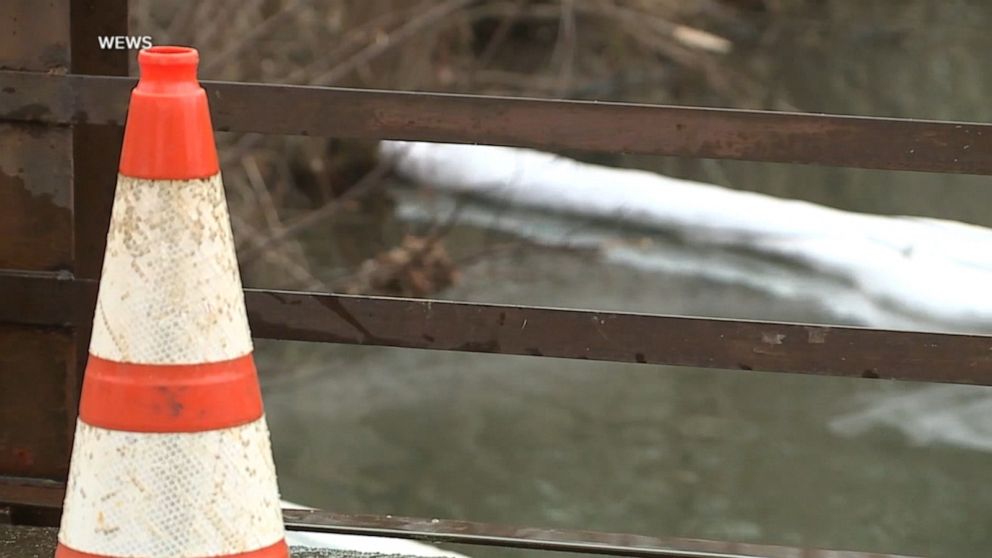Months Of Toxic Chemical Contamination Following Ohio Train Derailment

Table of Contents
H2: The Initial Disaster and Immediate Aftermath
On February 3, 2023, a Norfolk Southern freight train carrying hazardous materials derailed in East Palestine, Ohio. The subsequent inferno released a plume of toxic chemicals, including vinyl chloride, butyl acrylate, and ethylhexyl acrylate, into the air and surrounding environment. The immediate response involved a controlled burn of the vinyl chloride to prevent a potentially larger explosion, followed by mandatory evacuations of residents within a one-mile radius. Initial reports indicated significant air and water contamination, raising immediate health concerns.
- Date and location of the derailment: February 3, 2023, East Palestine, Ohio.
- Types and quantities of hazardous materials released: Vinyl chloride (approximately 100,000 pounds), butyl acrylate, ethylhexyl acrylate, and other hazardous materials. Precise quantities of all released chemicals are still being determined.
- Initial emergency response measures: Controlled burn of vinyl chloride, mandatory evacuations, initial air and water quality testing.
- Initial reports of air and water contamination: Reports of strong chemical odors, discoloration of local waterways, and concerns about air quality.
H2: Ongoing Water Contamination Concerns
Months after the derailment, concerns about water contamination persist. Residents report persistent foul odors and discoloration in their water, even after assurances from officials. While some testing indicates water is within EPA safety guidelines for drinking water, many residents remain skeptical, citing inconsistencies in testing methodologies and a lack of transparency from authorities. The long-term effects of exposure to even low levels of these chemicals remain unknown.
- Reports of contaminated drinking water sources: Residents report persistent concerns about their tap water, citing unusual taste, odor, and appearance.
- Testing methodologies and results: Testing results have varied, with some showing contaminants within EPA limits and others showing higher levels. The methodology used and the specific contaminants tested for have been subject to scrutiny.
- Government responses and assurances regarding water safety: Officials have repeatedly assured the public that the water is safe, but this reassurance has not allayed all concerns.
- Long-term monitoring plans and their effectiveness: Long-term monitoring plans are in place, but their effectiveness is still being assessed.
- Resident reports of health issues potentially linked to water contamination: Residents report various health issues, including nausea, headaches, and skin rashes, which they suspect are related to the contaminated water.
H2: Soil Contamination and its Long-Term Impacts
The extent of soil contamination from the spilled chemicals remains a significant concern. The potential for long-term environmental damage is considerable, impacting agricultural lands and local ecosystems. The long-term implications for the food chain and local wildlife are also a pressing issue. Remediation efforts are underway, but the full scope and effectiveness of these efforts remain uncertain.
- Assessment of soil contamination levels: Comprehensive assessments of soil contamination are still underway, making a complete picture difficult to obtain.
- Potential impact on agriculture and local ecosystems: Contaminated soil can render farmland unusable, affecting local agriculture and the surrounding environment.
- Remediation efforts and their effectiveness: Cleanup efforts are ongoing, but the scale and long-term success of these efforts are yet to be fully determined.
- Long-term monitoring of soil health: Continuous monitoring of soil health is crucial to assess the long-term consequences of the contamination.
- Potential for bioaccumulation in the food chain: The potential for bioaccumulation of these chemicals in the food chain presents a serious and ongoing threat to both wildlife and human health.
H2: Health Effects on Residents and the Environment
East Palestine residents have reported a wide range of health issues since the derailment, including headaches, respiratory problems, skin irritation, and other ailments. The long-term health consequences of exposure to these toxic chemicals are unknown, requiring extensive and ongoing health monitoring. The impact on wildlife and local ecosystems is also cause for serious concern.
- Reported health problems in East Palestine residents: Headaches, respiratory issues, skin irritation, nausea, and other symptoms.
- Studies investigating the link between chemical exposure and health problems: Independent studies are needed to establish a definitive link between chemical exposure and reported health issues.
- Impact on wildlife and local ecosystems: The impact on local flora and fauna is significant and requires long-term monitoring.
- Long-term health monitoring plans: Long-term health monitoring programs are essential to track the health of residents exposed to the chemicals.
- Potential for future health complications: The long-term health impacts of exposure to these chemicals are unknown and may manifest years later.
H2: Government Response and Accountability
The government response to the crisis has faced significant criticism. While the EPA is conducting investigations and Norfolk Southern is undertaking cleanup efforts, questions remain about the adequacy and transparency of the response. Legal actions against Norfolk Southern are underway, but the long-term accountability remains to be seen.
- EPA investigations and findings: The EPA continues its investigation into the extent of the contamination and the effectiveness of the cleanup efforts.
- Legal actions against Norfolk Southern: Lawsuits have been filed against Norfolk Southern, but the outcome of these legal proceedings remains uncertain.
- Government funding for cleanup and remediation: Federal funding has been allocated for cleanup, but it may not be sufficient to address the long-term needs.
- Criticism of the government's response: The government's response has been criticized for its slowness, lack of transparency, and insufficient resources.
- Transparency and communication with affected residents: Communication with residents has been inconsistent and insufficient, leading to distrust and ongoing concerns.
3. Conclusion:
Months after the Ohio train derailment, the toxic chemical contamination continues to pose a significant threat to public health and the environment. The long-term effects remain uncertain, highlighting the need for comprehensive investigation, robust remediation efforts, and transparent communication from authorities. The ongoing concerns underscore the importance of stringent railway safety regulations and environmental protection measures. The long-term consequences of this environmental disaster necessitate continued vigilance and demand for accountability.
Call to Action: Stay informed about the ongoing situation regarding the Ohio train derailment and the lasting effects of toxic chemical contamination. Demand accountability from responsible parties and advocate for stronger environmental protections to prevent future disasters. Learn more about the latest developments concerning the Ohio train derailment and its ongoing impact. Demand safer transportation of hazardous materials and stronger environmental regulations to protect our communities.

Featured Posts
-
 Stanley Cup Playoffs Us Ratings Decline Offset By Increased International Viewership
May 05, 2025
Stanley Cup Playoffs Us Ratings Decline Offset By Increased International Viewership
May 05, 2025 -
 Ufc 210 Cormier Vs Johnson Ii Fight Breakdown And Betting Odds
May 05, 2025
Ufc 210 Cormier Vs Johnson Ii Fight Breakdown And Betting Odds
May 05, 2025 -
 Louisiana Derby 2025 Expert Picks Odds Comparison And Road To The Kentucky Derby
May 05, 2025
Louisiana Derby 2025 Expert Picks Odds Comparison And Road To The Kentucky Derby
May 05, 2025 -
 Broadcoms V Mware Acquisition A 1 050 Price Increase Concerns At And T
May 05, 2025
Broadcoms V Mware Acquisition A 1 050 Price Increase Concerns At And T
May 05, 2025 -
 Effective Middle Management A Foundation For Strong Teams And Business Results
May 05, 2025
Effective Middle Management A Foundation For Strong Teams And Business Results
May 05, 2025
